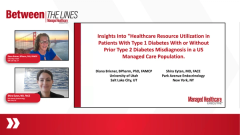
Advancing Diagnostic Precision in Type 1 Diabetes
Panelists discuss how autoantibody testing has high diagnostic accuracy with nearly 100% conversion to hyperglycemia when two or more antibodies are present, though timing of testing is crucial and retesting may be necessary since antibody levels can fluctuate over time.
Episodes in this series

This final segment addresses concerns about the diagnostic accuracy of autoantibody testing for type 1 diabetes from both clinical and payer perspectives. The study results demonstrated substantial and significant increases in healthcare resource utilization between the two cohorts, without apparent issues regarding test accuracy. From a payer standpoint, there are valid concerns about the specificity and sensitivity of autoantibody testing, particularly as its use becomes more widespread in clinical practice.
The clinical evidence strongly supports the diagnostic value of autoantibody testing. When patients have two or more positive antibodies, there is nearly 100% conversion to hyperglycemia during their lifetime, making the test highly predictive. However, some diagnostic complexity exists with single antibody positivity or antibody-negative high-risk patients. Antibodies can fluctuate throughout a person’s lifetime, typically being higher in childhood and potentially waning in adulthood or even after becoming hyperglycemic. Some patients may convert from antibody-positive to antibody-negative status over time, requiring clinicians to maintain a low threshold for retesting when clinical suspicion remains high.
The timing and frequency of antibody retesting depends on clinical circumstances. For patients with changing hemoglobin A1c levels, retesting may be appropriate within six months rather than years later. In early childhood screening of high-risk individuals with strong family history or associated autoimmune conditions, retesting after a few years is recommended. The discussion concludes by emphasizing the significant impact of early and accurate autoantibody testing in avoiding the unnecessary components of the diagnostic odyssey. This approach benefits both patients, who can receive appropriate treatment sooner and avoid complications, and payers, who can reduce the economic burden associated with prolonged misdiagnosis and inappropriate resource utilization patterns.
Newsletter
Get the latest industry news, event updates, and more from Managed healthcare Executive.

















































